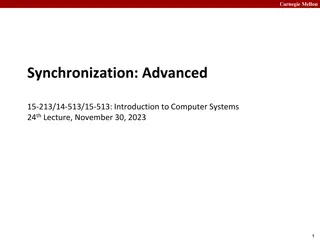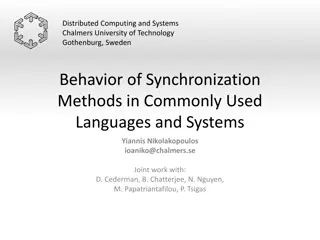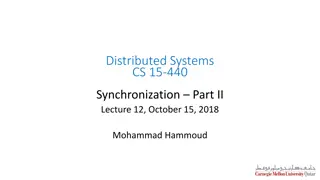
Thread Synchronization and Shared Resources for Efficient Programming
Learn about thread synchronization and shared resources management in programming. Explore concepts like locks, mutexes, and coordination patterns to prevent unexpected results in concurrent programming. Dive into a practical example of managing a shared bank account and see the importance of controlling access to shared variables.
Uploaded on | 0 Views
Download Presentation

Please find below an Image/Link to download the presentation.
The content on the website is provided AS IS for your information and personal use only. It may not be sold, licensed, or shared on other websites without obtaining consent from the author. If you encounter any issues during the download, it is possible that the publisher has removed the file from their server.
You are allowed to download the files provided on this website for personal or commercial use, subject to the condition that they are used lawfully. All files are the property of their respective owners.
The content on the website is provided AS IS for your information and personal use only. It may not be sold, licensed, or shared on other websites without obtaining consent from the author.
E N D
Presentation Transcript
Synchronization CPEN 331, UBC Alexandra Fedorova
Shared Resources Shared Resources Basic problem: Two concurrent threads are accessing a shared variable If the variable is read/modified/written by both threads, then access to the variable must be controlled Otherwise, unexpected results may occur Over the next two lectures, we ll look at: Mechanisms to control access to shared resources Low-level mechanisms: locks Higher level mechanisms: mutexes, semaphores, and condition variables Patterns for coordinating access to shared resources
Shared Variable Example Shared Variable Example Suppose we implement a function to withdraw money from a bank account: int withdraw(account, amount) { balance = get_balance(account); balance = balance - amount; put_balance(account, balance); return balance; } Now suppose that you and your roommate share a bank account with a balance of $1500.00 (not that this is necessarily a good idea...) What happens if you both go to separate ATM machines, and simultaneously withdraw $100.00 from the account?
Shared Variable Example (continued) Shared Variable Example (continued) We represent the situation by creating a separate thread for each ATM user doing a withdrawal Both threads run on the same bank server system THREAD 2 THREAD 1 int withdraw(account, amount) { balance = get_balance(account); balance = balance - amount; put_balance(account, balance); return balance; } Starting balance = $1500, each thread withdraws $100. What are possible balance values after each thread runs? int withdraw(account, amount) { balance = get_balance(account); balance = balance - amount; put_balance(account, balance); return balance; }
Interleaved Execution: Single CPU Interleaved Execution: Single CPU balance = get_balance(account); balance = balance amount; get_balance(account); balance = balance - amount; put_balance(account, balance); What is a context switch? context switch balance = time context switch put_balance(account, balance); return balance; Interleaved Execution: Many CPUs Interleaved Execution: Many CPUs THREAD 1 THREAD 2 int withdraw(account, amount) { balance = get_balance(account); balance = balance - amount; put_balance(account, balance); return balance; int withdraw(account, amount) { balance = get_balance(account); balance = balance - amount; put_balance(account, balance); time Arbitrary interleaving of instructions
What are the possible values of What are the possible values of n n if the following function is executed concurrently by two threads? function is executed concurrently by two threads? if the following /* Assume the starting value of counter is 1 */ /* Each thread invokes the function only once */ A. 1 B. 2 C. 3 D. All of the above E. B and C volatile int counter; void increment_global_counter() { counter++; }
Race Conditions Race Conditions The problem is that two concurrent threads access a shared resource without any synchronization This is called a race condition The result of the concurrent access is non-deterministic Result depends on: Timing When context switches occurred Which thread ran at at context switch What the threads were doing
Which resources are shared? Which resources are shared? Local variables in a function are not shared They exist on the stack, and each thread has its own stack You can't safely pass a pointer from a local variable to another thread Why? Global variables are shared Stored in static data portion of the address space Accessible by any thread Dynamically-allocated data is shared Stored in the heap, accessible by any thread
Mutual Exclusion Mutual Exclusion We want to use mutual exclusion to synchronize access to shared resources Meaning: When only one thread can access a shared resource at a time. Code that uses mutual exclusion to synchronize its execution is called a critical section Only one thread at a time can execute code in the critical section All other threads are forced to wait on entry When one thread leaves the critical section, another can enter
Critical Section Requirements Critical Section Requirements Mutual exclusion At most one thread is currently executing in the critical section Progress If thread T1 is outside the critical section, then T1 cannot prevent T2 from entering the critical section Bounded waiting (no starvation) If thread T1 is waiting on the critical section, then T1 will eventually enter the critical section Assumes threads eventually leave critical sections Performance The overhead of entering and exiting the critical section is small with respect to the work being done within it
Locks Locks A lock is an object (in memory) that provides the following two operations: acquire(): a thread calls this before entering a critical section May require waiting to enter the critical section release(): a thread calls this after leaving a critical section Allows another thread to enter the critical section A call to acquire( ) must have a corresponding call to release( ) Between acquire() and release(), the thread holds the lock acquire() does not return until the caller releases the lock At most one thread can hold a lock at a time (though there are exceptions!) What can happen if acquire( ) and release( ) calls are not paired?
Using Locks Using Locks int withdraw(account, amount) { acquire(lock); balance = get_balance(account); balance = balance - amount; put_balance(account, balance); release(lock); return balance; } critical section Why is the return statement outside of the critical section?
Take a look at the following code. Assume that the initial account balance is $1000, and balance is a global variable. The value for the amount argument is $100. Suppose that two threads are running this code concurrently. Which are all the possible values for the account balance after the threads are done? void withdraw(account, amount) { int new_bal; A. 1000, 800, 900 B. 800 C. 900, 800 D. 900, 800, some other value lock_acquire(account->lock); new_bal = balance; new_bal -= amount; lock_release(account->lock); lock_acquire(account->lock); balance = new_bal; lock_release(account->lock); }
A Common Pitfall A Common Pitfall Suppose you wanted to add some error-checking to your code: int withdraw(account, amount) { acquire(lock); balance = get_balance(account); if(balance < 0) return ERROR; balance = balance - amount; ret = put_balance(account, balance); if(ret < 0) return ERROR; release(lock); return balance; } Do you see a problem with this code?
Execution with Locks Execution with Locks acquire(lock); balance = get_balance(account); balance = balance amount; acquire(lock); Thread 1 runs Thread 2 waits on lock put_balance(account, balance); release(lock); balance = get_balance(account); balance = balance - amount; put_balance(account, balance); release(lock); Thread 1 completes Thread 2 resumes What happens when the yellow thread tries to acquire the lock?
Implementing Synchronization Primitives Subject of Assignment 2
Spinlocks Spinlocks A very simple way to implement spinlocks: struct lock { int held = 0; } void acquire(lock) { while (lock->held) ; lock->held = 1; } void release(lock) { lock->held = 0; } Why doesn t this work? Where is the race condition? The caller busy waits
Spinlocks Spinlocks Problem is that the internals of the lock acquire/release have critical sections too! The acquire() and release() actions must be atomic Atomic means that the code cannot be interrupted during execution All or nothing execution struct lock { int held = 0; } void acquire(lock) { while (lock->held) ; lock->held = 1; } void release(lock) { lock->held = 0; } What happens if there is a context switch here? This sequence needs to be atomic
Spinlocks Spinlocks Problem is that the internals of the lock acquire/release have critical sections too! The acquire() and release() actions must be atomic Atomic means that the code cannot be interrupted during execution All or nothing execution Doing this requires help from hardware! Disabling interrupts Why does this prevent a context switch from occurring? Will this work on a multiprocessor? Atomic instructions CPU guarantees entire action will execute atomically Test-and-set Compare-and-swap
What is test What is test- -and and- -set? set? 1. 2. A hardware implementation of locks A software implementation of locks that uses some special hardware instructions An instruction that in a single action sets the memory value to one and returns the previous value of that memory location An instruction that atomically checks if the lock is available and marks it as taken Of the four statements above, which one(s) is/are correct? A. 1 B. 2 C. 3 D. 4 E. 3 and 4 3. 4.
Spinlocks using test Spinlocks using test- -and and- -set set Semantics of test-and-set implemented in hardware So to fix our broken spinlocks, we do this: struct lock { int held = 0; } bool test_and_set(bool *flag) { bool old = *flag; *flag = True; return old; } void acquire(lock) { while(asm( __tst_and_set (&lock- >held))); } void release(lock) { lock->held = 0; } Why is it okay to do this without an atomic instruction?
Actually, there is still a bug in the code I have Actually, there is still a bug in the code I have shown you! shown you!
Volatile Volatile The variable holding the lock status must be declared volatile. The volatile keyword tells the compiler that the value of the variable might change at any time due to an event outside of the current code. What might cause such a change? The compiler then won t optimize the code by caching the variable in a register The program will re-read the value from memory every time it is accessed struct lock { volatile int held = 0; } void acquire(lock) { while(asm(tst_and_set(&lock- >held))); } void release(lock) { lock->held = 0; }
Problems with spinlocks (1) Problems with spinlocks (1) Spinning is expensive on modern processors Every tst_and_set reads and writes the value in memory! A common optimization is to simply spin on a variable, without an atomic operation until the lock looks free : This way we are just reading it from the CPU cache. struct lock { volatile int held = 0; } void acquire(lock) { while(asm(tst_and_set(&lock- >held))); } void release(lock) { lock->held = 0; }
Problems with spinlocks (1) Problems with spinlocks (1) Spinning is expensive on modern processors Every tst_and_set reads and writes the value in memory! A common optimization is to simply spin on a variable, without an atomic operation until the lock looks free : This way we are just reading it from the CPU cache. And then try to test-and-set it. This is called test-and-test-and-set. struct lock { volatile int held = 0; } void acquire(lock) { retry: while(lock->held) ; if (test_and_set(&lock- >held)) goto retry; } void release(lock) { lock->held = 0; } What happens if many threads try to do that?
Problems with spinlocks (2) Problems with spinlocks (2) Horribly wasteful! Threads waiting to acquire locks spin on the CPU Eats up lots of cycles, slows down progress of other threads Note that other threads can still run... how? Spinlocks can be used as primitives to build higher-level synchronization constructs
Spinlock alternative: Disabling Interrupts Spinlock alternative: Disabling Interrupts Take a look at the following implementation of a lock. Which statements are true? struct lock { // Note no state! } A. This implementation would work correctly on a processor like MIPS R3000 B. This implementation can be used only inside the kernel. C. This implementation is only correct if we have a single CPU. D. A and B. E. B and C void acquire(lock) { // disable interrupts on current CPU splraise(IPL_NONE, IPL_HIGH); } void release(lock) { // re-enable interrupts spllower(IPL_HIGH, IPL_NONE);}
Take a look at these two spinlock acquire implementations. Select the statement that most accurately compares the two: void acquire(lock) { retry: while(lock while(lock- ->held) if(test_and_set test_and_set(&lock->held)) goto retry; //lock not acquired } 1 A. The first one is correct, the second one is not. B. The second one is correct, the first one is not. C. They are functionally equivalent, but one of them will generate more memory traffic. D. They are functionally equivalent, but the while loop in the first implementation could be replaced with an if-statement without any effects on correctness or performance. >held) ; //spin ; //spin void acquire(lock) { while(test_and_set test_and_set(&lock->held)) ; //spin } 2
Test Test- -and and- -test test- -and and- -set in OS161? set in OS161? Exercise: find the spinlock implementation in OS161, read the code and understand what it does.
Spinlock implementation in OS161 Spinlock implementation in OS161 It does BOTH: Disables interrupts AND spins! WHY? What would happen if you didn t disable interrupts? And what do you need this for?
Blocking Synchronization Primitives Blocking Synchronization Primitives Blocking is an alternative to spinning (or busy-waiting) A thread that cannot immediately acquire the lock gives up the CPU Other threads can run on that CPU in the meantime (including the thread holding the lock) Why does spinning NOT make sense on a uniprocessor? When the lock is released, the thread is awaken How to implement the blocking-awakening? Requires careful synchronization of its own. How to make sure that the thread does not miss the signal and stay blocked forever?
Implementing a blocking semaphore Implementing a blocking semaphore I expect that you are familiar with semaphores from watching the videos! What is a semaphore: If semaphore count is zero, threads wait. If semaphore count is above zero, they can enter critical section. P() decrement the semaphore count (try to enter critical section) V() increment the semaphore count (exit from critical section) Exercise: let s try to implement it together and then go over the implementation is OS161. Your should now be ready to implement locks and condition variables for Assignment 2!






















